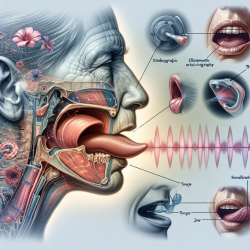Introduction
Amyotrophic Lateral Sclerosis (ALS) is a progressive neurodegenerative disease that affects motor neurons, leading to muscle weakness and atrophy. Among the earliest and most challenging symptoms for individuals with ALS are speech and swallowing impairments. A recent study titled Lingual and Jaw Kinematic Abnormalities Precede Speech and Swallowing Impairments in ALS explores the potential for early detection of these impairments through kinematic analysis.
Research Overview
The study utilized 3D electromagnetic articulography (EMA) to assess tongue and jaw movements in individuals with ALS who were not yet exhibiting clinically detectable bulbar impairments. The research involved 16 ALS patients and 18 neurotypical controls, matched for age, and found significant differences in lingual and jaw kinematics between the groups.
Key Findings
- ALS patients showed reduced posterior lingual range of motion and slower posterior lingual speeds compared to controls.
- There was an increased range of motion and speed in jaw movements among ALS patients.
- Lingual coordination was affected, with ALS patients showing longer swallowing durations but shorter lags between anterior and posterior tongue movements.
Clinical Implications
The findings suggest that kinematic differences in tongue and jaw movements can serve as early indicators of bulbar involvement in ALS, even before clinical symptoms are apparent. This early detection is crucial for timely intervention, which can improve patient outcomes.
For speech-language pathologists, incorporating kinematic analysis into clinical assessments could enhance the sensitivity of detecting early bulbar changes. Although current technology like EMA is not yet feasible for widespread clinical use due to cost and complexity, it provides a valuable benchmark for developing more accessible diagnostic tools.
Future Directions
Further research is needed to validate these findings across larger populations and diverse ALS stages. Additionally, exploring the integration of simpler, cost-effective technologies for routine clinical assessments could revolutionize early diagnosis and management of ALS-related speech and swallowing disorders.
Practitioners are encouraged to stay informed about advancements in diagnostic technologies and consider participating in research to further refine these methods. Understanding the nuances of tongue and jaw kinematics can empower clinicians to make data-driven decisions that enhance patient care.
To read the original research paper, please follow this link: Lingual and Jaw Kinematic Abnormalities Precede Speech and Swallowing Impairments in ALS.










